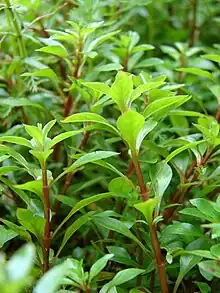Ludwigia palustris
Ludwigia palustris is a species of flowering plant in the evening primrose family known by the common names marsh seedbox,[1] Hampshire-purslane[2] and water purslane. This is an aquatic or semiaquatic perennial herb which grows in moist to wet to flooded areas. It is sometimes a weed. The species epithet palustris is Latin for "of the marsh" and indicates its common habitat.[3]
| Ludwigia palustris | |
|---|---|
 | |
| Scientific classification | |
| Kingdom: | Plantae |
| Clade: | Tracheophytes |
| Clade: | Angiosperms |
| Clade: | Eudicots |
| Clade: | Rosids |
| Order: | Myrtales |
| Family: | Onagraceae |
| Genus: | Ludwigia |
| Species: | L. palustris |
| Binomial name | |
| Ludwigia palustris | |
Description
The stem is up to half a meter (20 in) long and spreads to form mats on the mud, rooting at nodes in contact with the substrate, or floats ascending in the water. The leaves are oppositely arranged and green to red or purple in color. Solitary flowers appear in leaf axils. They are made up of tiny green sepals and no petals. They yield small capsular fruits containing many minute seeds.
Distribution
Its native distribution is unclear, but includes parts of the Americas; it can be found on most continents and spreads easily to become naturalized. It is also cultivated as an aquarium plant. It was identified in England in 1827.[4]
References
- USDA, NRCS (n.d.). "Ludwigia palustris". The PLANTS Database (plants.usda.gov). Greensboro, North Carolina: National Plant Data Team. Retrieved 22 December 2015.
- BSBI List 2007 (xls). Botanical Society of Britain and Ireland. Archived from the original (xls) on 2015-06-26. Retrieved 2014-10-17.
- Archibald William Smith A Gardener's Handbook of Plant Names: Their Meanings and Origins, p. 258, at Google Books
- Smail, H C P (1974). "William Borrer of Henfield, botanist and horticuIturaIist, 1781-1862". Watsonia. 10: 55–60.
External links
- Jepson Manual Treatment
- Missouri Plants Photo Profile
- Illinois Wildflowers
- VT Weed Identification
- Photo gallery